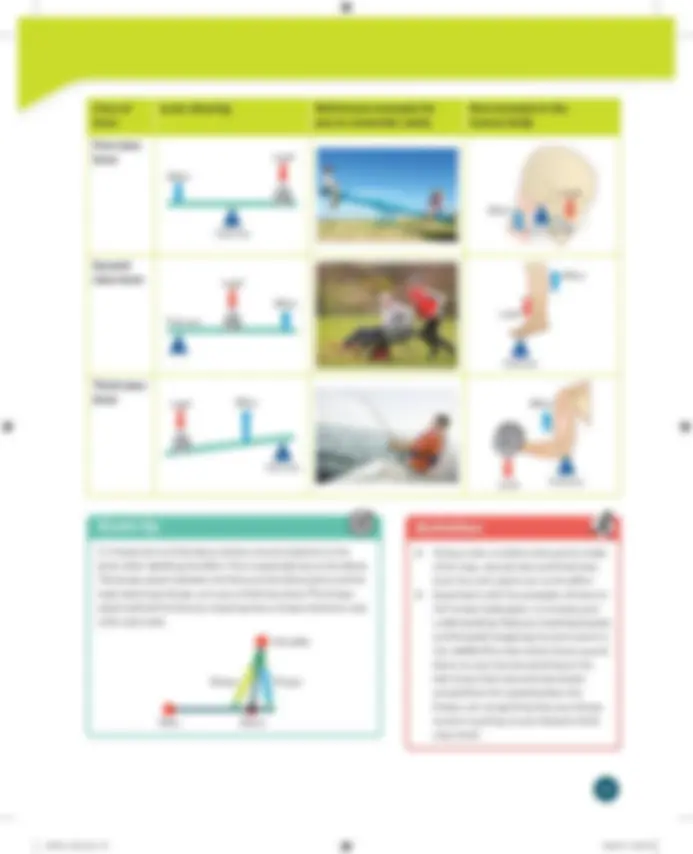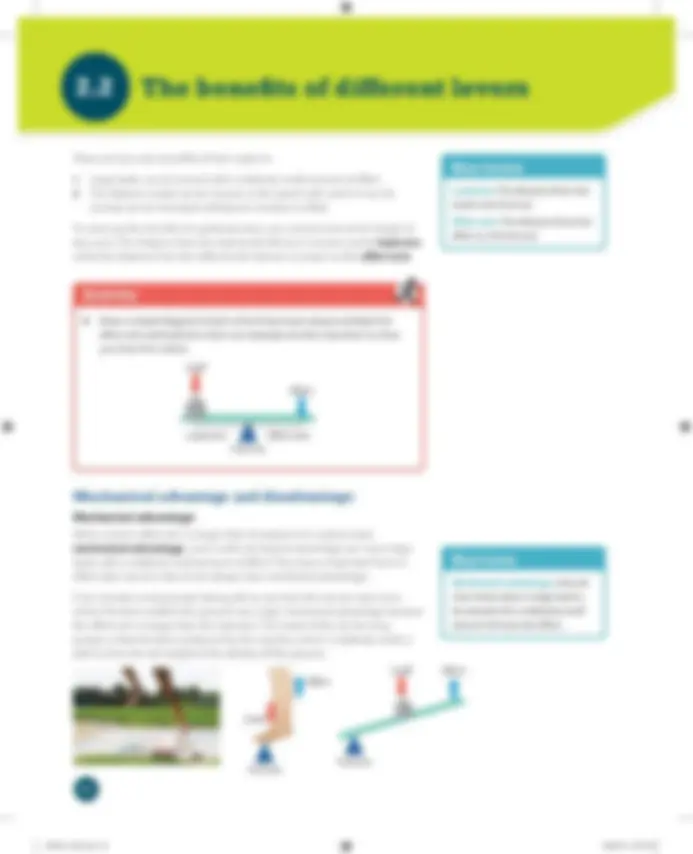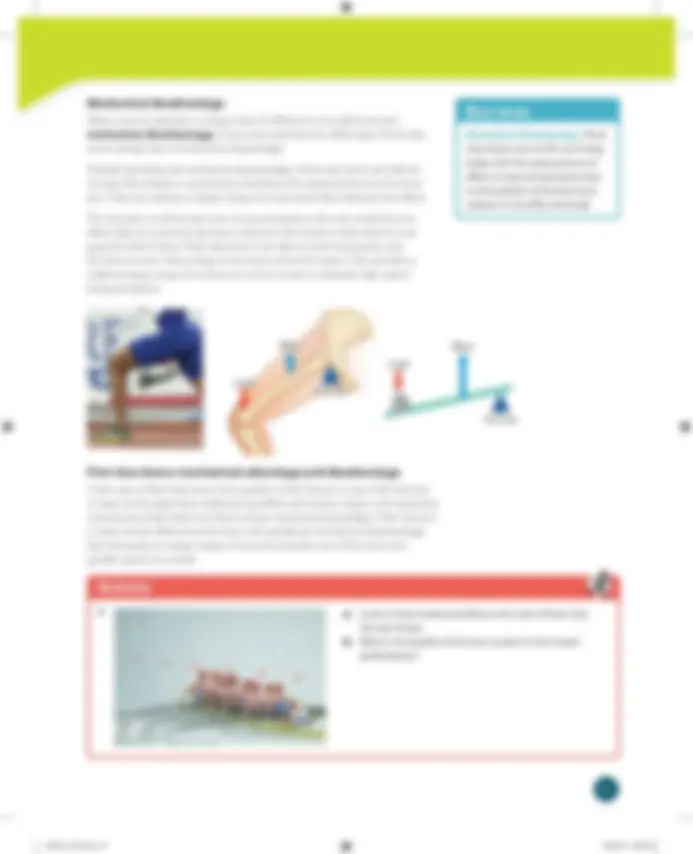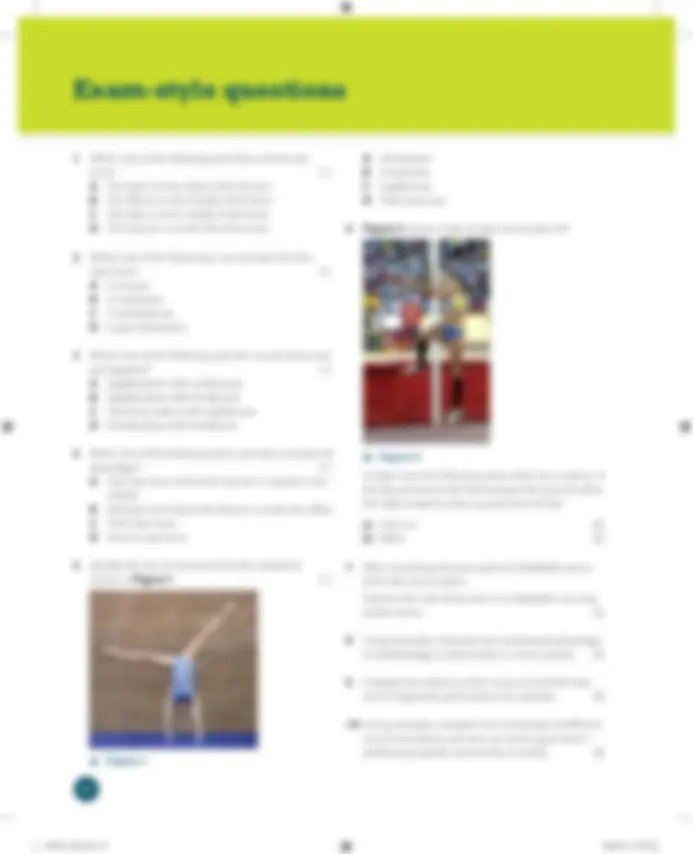






Study with the several resources on Docsity

Earn points by helping other students or get them with a premium plan


Prepare for your exams
Study with the several resources on Docsity

Earn points to download
Earn points by helping other students or get them with a premium plan
Community
Ask the community for help and clear up your study doubts
Discover the best universities in your country according to Docsity users
Free resources
Download our free guides on studying techniques, anxiety management strategies, and thesis advice from Docsity tutors
An introduction to levers, their classes, and their impact on sports performance. Learn about first, second, and third class levers, mechanical advantage and disadvantage, and planes and axes of movement. Useful for students studying kinesiology, exercise science, or sports performance.
What you will learn
Typology: Schemes and Mind Maps
1 / 8

This page cannot be seen from the preview
Don't miss anything!





2.1 Levers
Activity
1
The picture shows how a lever can be useful. a) Explain how this lever works and what advantage a person gains using a lever in this situation. b) Can you identify the fulcrum, effort and load in the picture?
Key terms
Lever: A rigid bar or object that moves around a fixed fulcrum with two forces applied to it. Fulcrum: A fi xed pivot point. For example, a joint in the body. Effort: The source of the energy. For example, muscles in the body. Load: The weight/resistance to be moved. For example, a body part plus anything held or resistance met.
Key term
Class of lever: The type of lever. There are fi rst class, second class and third class levers.
Exam tip
You will be expected to draw and label simple lever set-ups, so you’ll need a method for remembering the difference between fi rst, second and third class levers.
Try imagining: one see-saw, two wheelbarrows and three fi shing rods.
Or use the mnemonic “1, 2, 3, F, L, E” to help you remember the middle element of each class of lever.
First, second and third class levers
2.2 The benefi ts of different levers
Key terms
Load arm: The distance from the load to the fulcrum. Effort arm: The distance from the effort to the fulcrum.
Key term
Mechanical advantage: Second class levers allow a large load to be moved with a relatively small amount of muscular effort.
Fulcrum
Load Effort
Fulcrum
Effort
Load
Activity
4 Draw a simple diagram of each of the three lever classes and label the effort arm and load arm. Here is an example of a first class lever to show you how this is done.
Mechanical advantage and disadvantage
Mechanical advantage
Fulcrum
Load arm Effort arm
Effort
Load
Mechanical disadvantage
Key term
Mechanical disadvantage: Third class levers cannot lift such heavy loads, with the same amount of effort, as second class levers due to the position of the fulcrum in relation to the effort and load.
First class levers: mechanical advantage and disadvantage
Load Load Fulcrum
Effort
Fulcrum
Effort
Activity
(^5) a) Look at these rowers and discuss the class of lever that the oars create. b) What is the benefit of this lever system to the rowers’ performance?
Key terms
Frontal plane: An imaginary line dividing the body vertically from front to back. Sagittal plane: An imaginary line dividing the body vertically into left and right sides. Transverse plane: An imaginary line dividing the body horizontally from front to back. Frontal axis: An imaginary line passing horizontally through the body from left to right, allowing fl exion and extension. Sagittal axis: An imaginary line passing horizontally through the body from front to back, allowing abduction and adduction. Vertical axis: An imaginary line passing vertically through the body, allowing rotation of the body in an upright position.
The sagittal plane divides the body vertically into left and right sides. Movement occurs in the sagittal plane about the frontal axis. The frontal axis passes horizontally through the body from left to right, allowing flexion and extension.
Activity
6 a) Make a model of a person standing in the anatomical position from Plasticine or Play-Doh. Use a pencil as an axis and two pieces of card as a plane. Push your pencil through your model and attach a piece of card to either side to represent the corresponding plane. If you spin your pencil, the model will rotate around that axis and in line with the plane. b) Can you think of other sporting actions that take place in the planes and around the axes described on these two pages? They can be whole body movements or movements that involve only part of the body. c) Use your model to make a video presentation explaining planes and axes, using the examples you came up with for part b.
Exam tip
A wheel on a bike spins around a central axle. This is how an axis works. If you had an axis through your belly button, you’d spin like a wheel. Think of a plane as a thick sheet of glass that you’re trapped tightly inside. Movements that take place in that plane can only occur in the direction that the sheet of glass allows.
Sagittal plane
Frontal axis
Exam-style questions
Figure 1
Figure 2